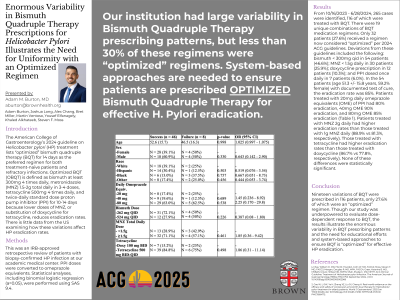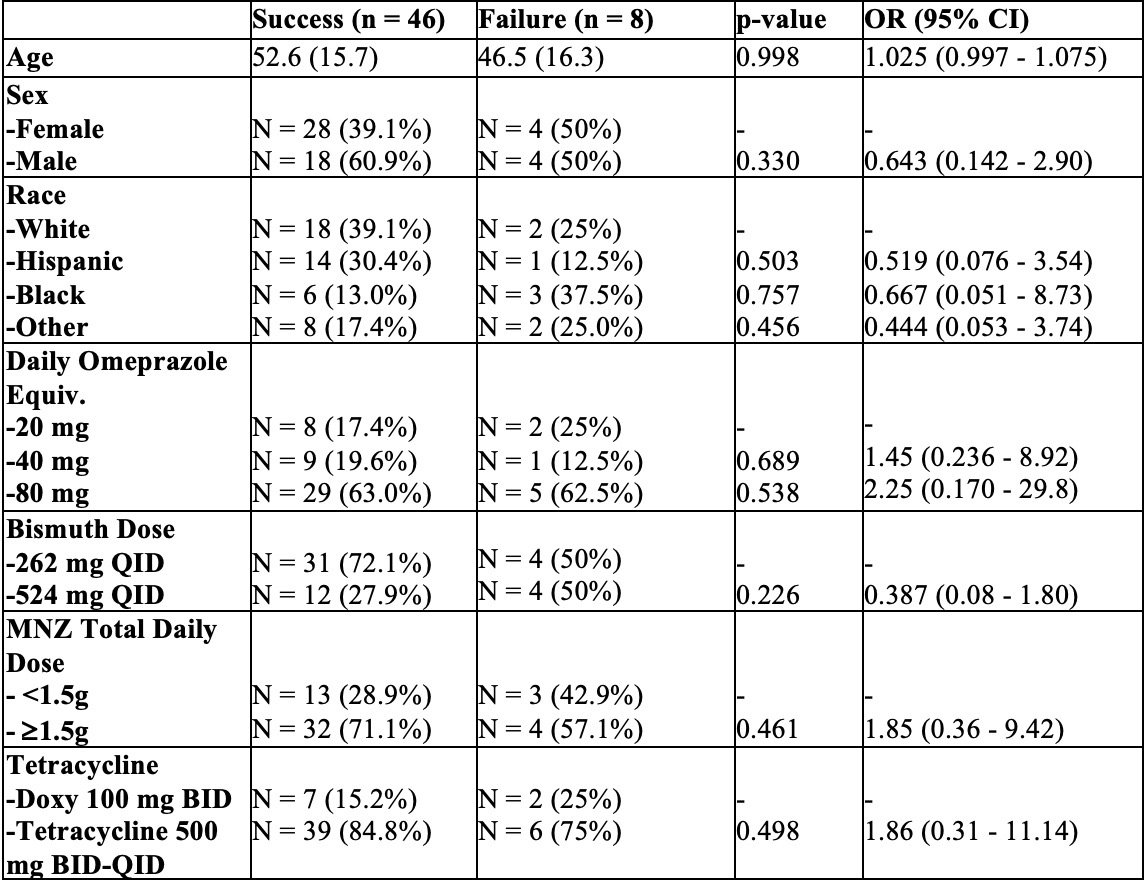Monday Poster Session
Category: Infections and Microbiome
P3437 - Enormous Variability in Bismuth Quadruple Therapy Prescriptions for Helicobacter pylori Illustrates the Need for Uniformity With an Optimized Regimen
Monday, October 27, 2025
10:30 AM - 4:00 PM PDT
Location: Exhibit Hall

Has Audio

Adam M. Burton, MD
Brown University / Rhode Island Hospital
Providence, RI
Presenting Author(s)
Adam M. Burton, MD1, Joshua D. Long, MD2, Alex Chang, MD1, Bret R. Miller, MD3, Martin Ventoso, MD1, Yousef Elfanagely, MD1, Khaled Alkhateeb, MBBS1, Steven F. Moss, MD4
1Brown University / Rhode Island Hospital, Providence, RI; 2Brown University, Providence, RI; 3Brown University / Warren Alpert Medical School, Providence, RI; 4Brown Medicine/Brown Physicians, Inc., Providence, RI
Introduction: The American College of Gastroenterology’s 2024 guideline on Helicobacter pylori (HP) treatment lists “optimized” bismuth quadruple therapy (BQT) for 14 days as the preferred regimen for both treatment-naïve patients and refractory infections. Optimized BQT (OBQT) is defined as bismuth at least 300mg 4 times daily, metronidazole (MNZ) 1.5-2g total daily in 3-4 doses, tetracycline 500mg 4 times daily, and twice-daily standard dose proton pump inhibitor (PPI) for 10-14 days because lower doses of MNZ, or substitution of doxycycline for tetracycline, reduces eradication rates. There is little data from the US examining how these variations affect HP eradication rates.
Methods: This was an IRB-approved retrospective review of patients with biopsy-confirmed HP infection at our academic medical center. PPI doses were converted to omeprazole equivalents. Statistical analyses, including binomial logistic regression (α=0.05), were performed using SAS 9.4.
Results: From 10/16/2023 - 6/28/2024, 265 cases were identified, 116 of which were treated with BQT. There were 19 unique combinations of BQT medication regimens. Only 32 patients (27.6%) received a regimen now considered “optimized” per 2024 ACG guidelines. Deviations from these guidelines included the following: bismuth < 300mg qid in 54 patients (46.6%); MNZ < 1.5g daily in 30 patients (25.9%); doxycycline prescription in 12 patients (10.3%); and PPI dosed once daily in 7 patients (6.0%). In the 54 patients (age 51.3 +/- 15.8 years, 59.2% female) with documented test of cure, the eradication rate was 85%. Patients treated with 20mg daily omeprazole equivalents (OME) of PPI had 80% eradication, 40mg OME 90% eradication, and 80mg OME 85% eradication (Table 1). Patients treated with MNZ 2g daily had higher eradication rates than those treated with 1g MNZ daily (88.9% vs 81.3%, respectively). Those treated with tetracycline had higher eradication rates than those treated with doxycycline (86.7% vs 77.8%, respectively). None of these differences were statistically significant.
Discussion: Nineteen variations of BQT were prescribed in 116 patients, only 27.6% of which were an “optimized” regimen. Though our study was underpowered to evaluate dose-dependent response to BQT, the results illustrate the enormous variability in BQT prescribing patterns and the need for educational efforts and system-based approaches to ensure BQT is “optimized” for effective HP eradication.

Disclosures:
Adam M. Burton, MD1, Joshua D. Long, MD2, Alex Chang, MD1, Bret R. Miller, MD3, Martin Ventoso, MD1, Yousef Elfanagely, MD1, Khaled Alkhateeb, MBBS1, Steven F. Moss, MD4. P3437 - Enormous Variability in Bismuth Quadruple Therapy Prescriptions for <i>Helicobacter pylori</i> Illustrates the Need for Uniformity With an Optimized Regimen, ACG 2025 Annual Scientific Meeting Abstracts. Phoenix, AZ: American College of Gastroenterology.
1Brown University / Rhode Island Hospital, Providence, RI; 2Brown University, Providence, RI; 3Brown University / Warren Alpert Medical School, Providence, RI; 4Brown Medicine/Brown Physicians, Inc., Providence, RI
Introduction: The American College of Gastroenterology’s 2024 guideline on Helicobacter pylori (HP) treatment lists “optimized” bismuth quadruple therapy (BQT) for 14 days as the preferred regimen for both treatment-naïve patients and refractory infections. Optimized BQT (OBQT) is defined as bismuth at least 300mg 4 times daily, metronidazole (MNZ) 1.5-2g total daily in 3-4 doses, tetracycline 500mg 4 times daily, and twice-daily standard dose proton pump inhibitor (PPI) for 10-14 days because lower doses of MNZ, or substitution of doxycycline for tetracycline, reduces eradication rates. There is little data from the US examining how these variations affect HP eradication rates.
Methods: This was an IRB-approved retrospective review of patients with biopsy-confirmed HP infection at our academic medical center. PPI doses were converted to omeprazole equivalents. Statistical analyses, including binomial logistic regression (α=0.05), were performed using SAS 9.4.
Results: From 10/16/2023 - 6/28/2024, 265 cases were identified, 116 of which were treated with BQT. There were 19 unique combinations of BQT medication regimens. Only 32 patients (27.6%) received a regimen now considered “optimized” per 2024 ACG guidelines. Deviations from these guidelines included the following: bismuth < 300mg qid in 54 patients (46.6%); MNZ < 1.5g daily in 30 patients (25.9%); doxycycline prescription in 12 patients (10.3%); and PPI dosed once daily in 7 patients (6.0%). In the 54 patients (age 51.3 +/- 15.8 years, 59.2% female) with documented test of cure, the eradication rate was 85%. Patients treated with 20mg daily omeprazole equivalents (OME) of PPI had 80% eradication, 40mg OME 90% eradication, and 80mg OME 85% eradication (Table 1). Patients treated with MNZ 2g daily had higher eradication rates than those treated with 1g MNZ daily (88.9% vs 81.3%, respectively). Those treated with tetracycline had higher eradication rates than those treated with doxycycline (86.7% vs 77.8%, respectively). None of these differences were statistically significant.
Discussion: Nineteen variations of BQT were prescribed in 116 patients, only 27.6% of which were an “optimized” regimen. Though our study was underpowered to evaluate dose-dependent response to BQT, the results illustrate the enormous variability in BQT prescribing patterns and the need for educational efforts and system-based approaches to ensure BQT is “optimized” for effective HP eradication.

Figure: Binary Logistic Regression Comparing Various Doses of H. Pylori Eradication Regimens on Treatment Outcome
Disclosures:
Adam Burton indicated no relevant financial relationships.
Joshua D. Long indicated no relevant financial relationships.
Alex Chang indicated no relevant financial relationships.
Bret Miller indicated no relevant financial relationships.
Martin Ventoso indicated no relevant financial relationships.
Yousef Elfanagely indicated no relevant financial relationships.
Khaled Alkhateeb indicated no relevant financial relationships.
Steven Moss indicated no relevant financial relationships.
Adam M. Burton, MD1, Joshua D. Long, MD2, Alex Chang, MD1, Bret R. Miller, MD3, Martin Ventoso, MD1, Yousef Elfanagely, MD1, Khaled Alkhateeb, MBBS1, Steven F. Moss, MD4. P3437 - Enormous Variability in Bismuth Quadruple Therapy Prescriptions for <i>Helicobacter pylori</i> Illustrates the Need for Uniformity With an Optimized Regimen, ACG 2025 Annual Scientific Meeting Abstracts. Phoenix, AZ: American College of Gastroenterology.
